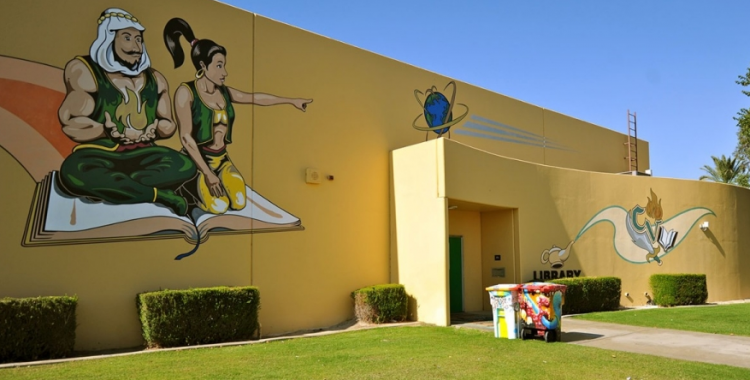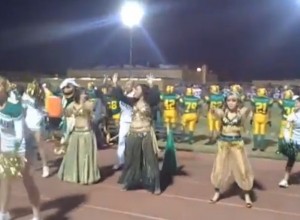
The Arabs of Coachella – remixing debates on Arab representation.
I wouldn’t know how to feel if I was Arab, went to a school with an Arabs mascot, but didn’t make the sports or dance teams. Or what if I was the punk I was and had no school spirit? Would it be a double disgrace? In response to the Coachella Valley Arabs Hishschool mascot debate, we asked UC Berkeley PhD candidate Adam Ahmed to analyze the situation in way that moves beyond misguided questions about whether the highschool “loves Arabs” or “offends Arabs,” and instead explores how the mascot 1) renders “Arabs” as a essentialized fixture of the past, 2) overrides contemporary diverse Arab identities, and 3) exemplifying the dominant American narrative of Arabs as either riding magic carpets, or dropping bombs*. Here we go!
————
The Arabs of Coachella
No, these aren’t the faceless 3rabs popping mollies and wilding out to Jus†ice in a sea of glowsticks. These are the timeless Arabs, whose specters make the image of those other Arabs inconceivable. These figures, which seem lifted from a dollar-store copy of the Arabian Nights, are the long-time mascot of Coachella Valley High School. Haya El Nasser and Nadeem Muaddi at Al Jazeera American recently dropped an article on the outlandish history of the mascot that shows how the mascot started as an expression of the region’s so called affinity with the Middle East due to its ability to grow dates (as if a fondness for dates makes you Arab), but quickly reenacted every bad Orientalist stereotype since the 19th century.
The turbaned figures adorning the school’s exterior, the half-time belly dancer show, and the marching band of harem girls reproduce a static image of the Orient that we’re too familiar with by now. But what’s worse than all of this, for me, is the name: The Arabs. Not one Arab, but all Arabs—the plural can’t be read as anything but an implied universality. This name assumes that these imagined representations lay claim to some essential nature of the people who identify as Arabs. As Eddy Said taught us, the threat of the Orientalist fantasy is in its projection of an imagined space onto a real place—the way it claims representative mastery over an actual people. So what’s at stake here is not the accuracy or inaccuracy of representation, but an appropriation of “Arab” as an identity an 3rab can claim for himself or herself. The depth this appropriation can be summarized in one absurd statement by a former Coachella Valley High student: “We have been ARABS since the 1930s and are proud of it.” I can only imagine the “solidarity” felt by any one of genuine Arab descent attempting to assert their individuality at this school.
As I lamented the fate of Oriental misrepresentations, and the difficulty of 3rabs like me to claim their heritage within such a cultural context, I stumbled across this passage:
The mascot has evolved over the years from a turbaned Arab on horseback carrying a lance, in the 1920s, to a young man in a fez holding a scimitar and an old man with a growling face and gold tooth, in the 1950s. The mascot changed again in the 1980s, after a group of Saudi Arabian visitors suggested the fez be changed to a hijab.
‘Their reasoning was that Saudi Arabia was no longer under French rule; therefore, Saudi Arabians no longer wore the fez as their headdress.’
Of course, the story may not be entirely accurate — as the hijab is the headscarf of Muslim women, the French never occupied Saudi Arabia and the fez, which originated in Morocco, owes its popularity in the Middle East to the Ottomans.
It’s hard to tell if these “traveling Saudis” are imagined only to justify an egregious lack of cultural awareness; nonetheless, these wandering Arabs show how the claims of representation can be reversed by a refusal to be representable. Similarly, while we lament particular instances of failed representation like this, we should remember to not subjugate ourselves to conversations where we’re forced to defend the true representation of the Arab. Such testimonies only replicate the skewed logic of representation—forcing us to prove the value of our traditions before a tribunal that doesn’t give a fuck about us. One way to counter these gross representations is to make ourselves invisible. By this I don’t mean self-effacement or self-denial. Rather, we should re-orient the visible aspects of our identity in a way that will implode the very logic of representation that demands that we show our true selves.
So in response to this Coachella Valley High mascot, I have a plan: let’s get a crew to pose as wandering Arabs from the future, and let’s make a post-Coachella visit to the Coachella Valley school board. As timeless experts in all things Arab we can inform the board that, contrary to popular belief, Arabs DO NOT have faces. And those loose, flowing garments conceal NO BODIES, only air. What remains is a whirlwind hungry for substance—a wisp of sand mingled with the scent of hash and coffee, the sound of a plucked oud, and the echo of muezzins.
Try to represent that, fuckers.
——
Adam Ahmed is a PhD candidate in English at UC Berkeley.
*(The fact that the one time the High School did considered changing their mascot due to its disconnect with Arab reality was only out of fear of perceived alliance post 9/11.)

I (and probably a few others) would like to see more dialogue on this subject in an inter-POC context, rather than in general hegemonic terms. Talk about intersectionality, virtually the entire Coachella Valley Unified School District’s leadership is POC…
POC can be complicit in hegemonic ways of thinking. I think regardless of the framework we’re operating in, the Arab identity is essentialized by the district and this threatens the sanctity of the culture.